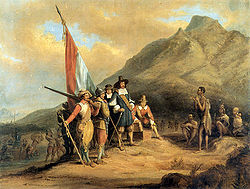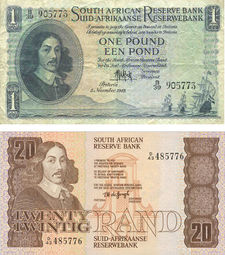Jan van Riebeeck
| Jan van Riebeeck | |
 |
|
|
|
|
|---|---|
| In office 7 April 1652 – 6 May 1662 |
|
| Preceded by | Office established |
| Succeeded by | Zacharias Wagenaer |
|
|
|
| Born | 21 April 1619 Culemborg, Gelderland |
| Died | 18 January 1677 (aged 57) Batavia |
| Resting place | Groote Kerk, Jakarta |
| Birth name | Johan Anthoniszoon van Riebeeck |
| Nationality | |
| Spouse(s) | Maria de la Quellerie |
| Children | Abraham van Riebeeck 7 others |
| Occupation | Colonial administrator |
Johan Anthoniszoon "Jan" van Riebeeck (April 21, 1619 – January 18, 1677) was a Dutch colonial administrator and founder of Cape Town.
Contents |
Biography
Van Riebeeck was born in Culemborg in the Netherlands as the son of a surgeon. He grew up in Schiedam, where he married 19-year old Maria de la Quellerie on 28 March 1649. (She died in Malacca, now part of Malaysia, on 2 November 1664, at the age of 35). The couple had eight children, most of whom did not survive infancy. Their son Abraham van Riebeeck, born at the Cape, later became Governor-General of the Dutch East Indies.
Joining the Dutch East India Company (VOC) in 1639, he served in a number of posts, including that of an assistant surgeon in the Batavia in the East Indies. He subsequently visited Japan. His most important position was that of head of the VOC trading post in Tonkin, Vietnam. However, he was called back from this post as it was discovered that he was conducting trade for his own account.
In 1651 he was requested to undertake the command of the initial Dutch settlement in the future South Africa. He landed three ships Drommedaris, Reijger and Goede Hoop at the future Cape Town on 6 April 1652 and fortified the site as a way-station for the VOC trade route between the Netherlands and the East Indies. The Walvisch and the Oliphant arrived later, having had 130 burials at sea.

Van Riebeeck was Commander of the Cape from 1652 to 1662; he was charged with building a fort, with improving the natural anchorage at Table Bay, planting fruit and vegetables and obtaining livestock from the indigenous Khoi people. In the Kirstenbosch National Botanical Garden in Cape Town there is a wild almond hedge still surviving that was planted on his orders as a barrier. The initial fort was made of mud, clay and timber, and had four corners or bastions. This first fort, Redout Duijnhoop[1], should not be confused with the present-day Cape Town Castle. The Castle, built between 1666 and 1679, several years after Van Riebeeck's departure, has five bastions and is made of brick, stone and cement.
Van Riebeeck reported the first comet discovered from South Africa, C/1652 Y1, which was spotted on December 17, 1652.
He died in Batavia (now renamed Jakarta) on the island of Java in 1677.
Legacy in South Africa


Jan van Riebeeck is of cultural and historical significance in South Africa among many of the Afrikaner population, who view him as the founding father of their nation. This regard was also prevalent in that his image appeared ubiquitously on stamps and the South African currency from the 1940s up until 1993 when the South African Reserve Bank changed the currency to an apolitical design of the fauna and flora of the region.
6 April used to be known as Van Riebeeck's Day, and later as Founder's Day but the holiday was abolished by the ANC government after the democratic elections of 1994. His image no longer features on any official currency or stamps, but statues of him and his wife remain standing in Adderley Street, Cape Town.
Many towns and villages these days still have streets named after him. The coat of arms of the city of Cape Town is based on the Van Riebeeck family coat of arms.
References
- Collins, Robert O. Central and South African history. Topics in world history. New York, NY, USA: M. Wiener Pub. 1990. ISBN 9781558760172.
- Hunt, John, and Heather-Ann Campbell. Dutch South Africa: early settlers at the Cape, 1652–1708. Leicester, UK: Matador 2005. ISBN 9781904744955.
- Riebeeck, Jan van, and Robert Kirby. The secret letters of Jan van Riebeeck. London, England, UK: Penguin Books 1992. ISBN 9780140177657.
Peace